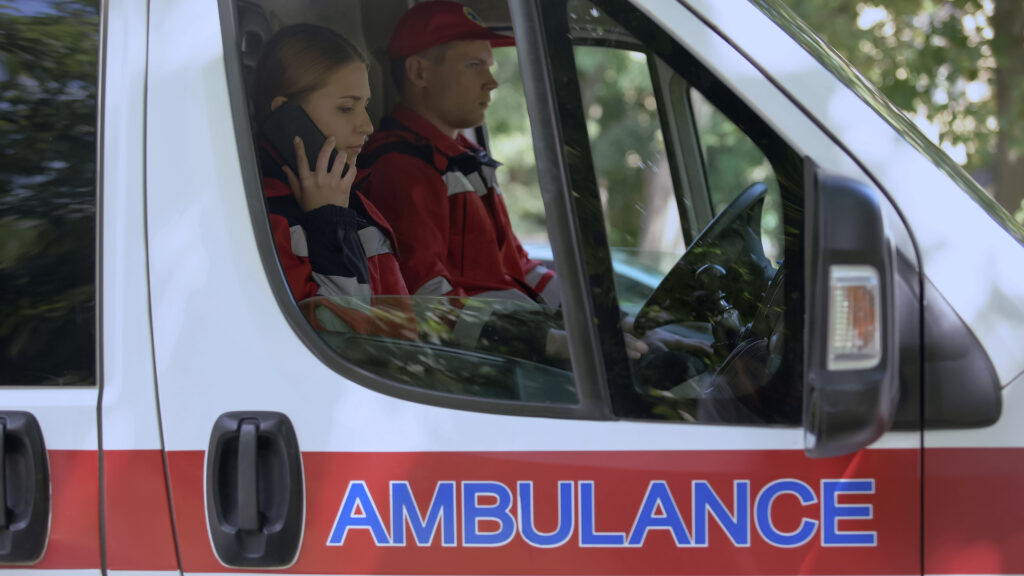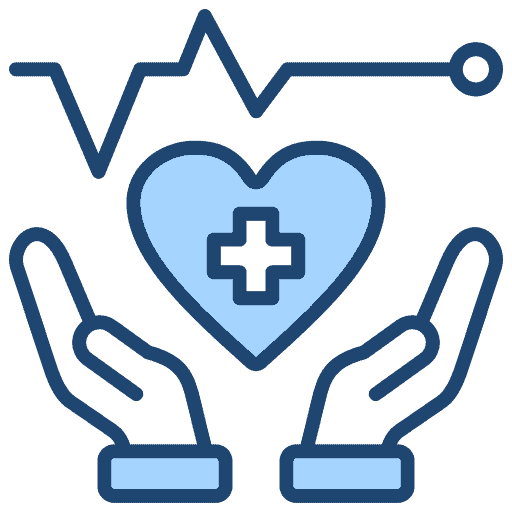
Every EMT or paramedic knows the feeling: you finish a tough call, adrenaline still in full effect, replaying moments in your head while you try to reset for the next run. Some days, it’s easy to shake off. On other days, one scene sticks. Over time, that weight can build.
Why do some people seem to bounce back quickly while others feel overwhelmed or burned out? The answer lies deep in our biology; in how our nervous system regulates stress, and how we can train it to recover more effectively.
Healthy stress regulation depends on the balance between the sympathetic and parasympathetic systems. The sympathetic nervous system (SNS) is your “fight, flight, or freeze” gear. The parasympathetic nervous system (PNS) is the “rest and digest” mode that helps you recover once the crisis passes. You need both: fast activation for emergencies, and reliable recovery afterward.
When stress hits, your HPA axis (the hypothalamus–pituitary–adrenal system) triggers adrenalin and cortisol release. That’s useful in the short term because it sharpens focus and readies your muscles.
However, if you stay revved up too long as a result of shift work (common in EMS), poor sleep, or repeated trauma exposure, cortisol stays elevated, and your nervous system never fully powers down. Your autonomic system is out of balance with an overactivation of the sympathetic system. Over time, this constant “on” state can lead to hypervigilance, anxiety, irritability, or burnout. In the worst cases, it sets the stage for post-traumatic stress symptoms.
These states aren’t just emotional, they’re physiological. Trauma can “rewire” the system, making it harder to return to a calm baseline. Some providers might feel chronically keyed up, while others shut down or disconnect as a way to cope. The goal of nervous system regulation is learning how to find your way back to calm after stress.
Not everyone responds to trauma the same way. Some EMS professionals can handle years of high-intensity work with steady nerves, while others find their resilience frays faster. The reasons aren’t about toughness; they’re about genetics, history, and context.
Research shows that variations in certain genes can influence how efficiently your body clears stress hormones. Some people’s systems simply hold onto stress signals longer.
Early exposure to adversity can also “prime” the nervous system for overreaction. Scientists call this epigenetic change; stress is turning certain genes on or off in ways that persist into adulthood.
Our ability to regulate stress starts in childhood. Kids who grow up with consistent, caring caregivers usually develop stronger self-regulation skills. Those with chaotic or neglectful environments may grow up more sensitive to threat cues — their nervous system learns to expect danger. That doesn’t mean people can’t change; it just means some start with a more reactive baseline.
Certain traits, like optimism or a strong sense of control, predict greater resilience. Conversely, high neuroticism or negative thinking styles can magnify stress effects. However, mindset can be trained, especially through practices like mindfulness or cognitive reframing.
EMS work piles on cumulative trauma, not one big event, but hundreds of small exposures that chip away at your reserves. Add in organizational stressors like shift rotations, limited downtime, and stigma around asking for help, and it’s easy to see why resilience can wear thin.
Even the most experienced providers aren’t immune. The body keeps the score, and without recovery, it collects interest.
The core skill behind resilience isn’t avoiding stress; it’s coming back to baseline after it. That’s nervous system regulation: the ability to notice when you’re dysregulated and use tools to reset. Some tools include breathing exercises, body-based experiencing, mindfulness-based stress reduction, exercise, human connection, and, of course, good sleep.
Your breath is one of the fastest ways to influence your autonomic state. Slow, controlled breathing, especially 5–6 breaths per minute increases heart rate variability (HRV). Even when your pulse seems steady, your heart isn’t actually beating at a perfectly even pace.
There’s a subtle variation in the time between each heartbeat: maybe 0.84 seconds between one pair, 0.88 between the next. That small, natural fluctuation is called Heart Rate Variability (HRV). Higher HRV means your heart rhythm naturally varies more from beat to beat, and that’s a good thing, the parasympathetic system is active and able to counterbalance the sympathetic fight or flight response.
This reflects a flexible, well-balanced nervous system that can shift smoothly between activation (stress) and recovery (calm). HRV biofeedback uses sensors or apps to visualize this rhythm, helping you train your vagus nerve to recover more quickly. In a 2024 clinical trial, HRV training significantly reduced anxiety and improved attention control.
Body-based therapies like Somatic Experiencing teach you to track subtle sensations, tension, heat, or tightness, and then release them gently. The idea behind Somatic Experiencing is that trauma isn’t just a memory in the mind; it’s also a physiological imprint left in the nervous system.
When something overwhelming happens; like a critical call, a crash, or a life-threatening event, your body automatically prepares to fight, flee, or freeze. If that energy doesn’t get fully released afterward, it can stay “stuck” in your system as chronic tension, hypervigilance, or emotional numbness.
Mindfulness-based stress reduction (MBSR) helps people notice internal signals without judgment. This is a form of meditation that is taught in an eight-week course throughout the country. One large 2023 study found MBSR worked as well as escitalopram (Lexapro) for anxiety, with fewer side effects. Mindfulness increases prefrontal control, your brain’s ability to calm the amygdala’s threat response.
Both cardio and resistance training improve stress tolerance by balancing cortisol, promoting endorphins, and strengthening the body’s feedback loops for calm. For shift workers, even short bursts of 10–15 minutes between calls can help reset your physiology.
Human connection is one of the strongest protective factors. After a hard call, your body reads safety cues not just from your environment but from other people’s tone, eye contact, and presence. Peer check-ins, supportive debriefs, or even a brief conversation with someone who “gets it” can calm your nervous system more effectively than white-knuckling alone.
Poor sleep hijacks stress regulation. Night shifts, caffeine, and alertness carryovers all mess with circadian rhythm. Protecting your sleep window, using blackout curtains, and scheduling regular off-shift wind-down time are powerful but often overlooked resilience tools.
Resilience isn’t just about “being tough.” It’s a dynamic skill, one that can be developed with intentional practice and support.
References:
Porges, S. W. (2011). The Polyvagal Theory: Neurophysiological Foundations of Emotions, Attachment, Communication, and Self-Regulation. W. W. Norton & Co.
van der Kolk, B. A. (2014). The Body Keeps the Score: Brain, Mind, and Body in the Healing of Trauma. Viking Press.
Kabat-Zinn, J. (2013) Full Catastrophe Living: Using the Wisdom of Your Body and Mind to Face Stress, Pain, and Illness. Revised and updated ed. New York: Bantam Books.
Ho JMC, Chan ASW, Luk CY, Tang PMK. Book Review: The Body Keeps the Score: Brain, Mind, and Body in the Healing of Trauma. Front Psychol. 2021 Aug 18;12:704974. https://pmc.ncbi.nlm.nih.gov/articles/PMC8418154/ accessed October 6, 2025
Hoge EA, Bui E, Mete M, Dutton MA, Baker AW, Simon NM. Mindfulness-Based Stress Reduction vs Escitalopram for the Treatment of Adults With Anxiety Disorders: A Randomized Clinical Trial. JAMA Psychiatry. 2023;80(1):13–21. https://jamanetwork.com/journals/jamapsychiatry/fullarticle/2798510#:~:text=Baseline%20mean%20(SD)%20CGI%2DS%20score%20was%204.44,for%20MBSR%20and%201.43%20(1.17)%20for%20escitalopram. Accessed October 7, 2025
Goessl VC, Curtiss JE, Hofmann SG. The effect of heart rate variability biofeedback training on stress and anxiety: a meta-analysis. Psychol Med. 2017 Nov;47(15):2578-2586. https://pubmed.ncbi.nlm.nih.gov/28478782/ Accessed October 7, 2025
Kim HG, Cheon EJ, Bai DS, Lee YH, Koo BH. Stress and Heart Rate Variability: A Meta-Analysis and Review of the Literature. Psychiatry Investig. 2018 Mar;15(3):235-245.
https://pmc.ncbi.nlm.nih.gov/articles/PMC5900369/ accessed October 7,2025
Saito, K., Yoshida, T., Sawamura, D., Watanabe, K., Tokikuni, Y. and Sakai, N. (2024) ‘Effects of heart rate variability biofeedback training on anxiety reduction and brain activity: a randomized active-controlled study using EEG’, Applied Psychophysiology and Biofeedback, 49(2), pp. 171–185. https://d197for5662m48.cloudfront.net/documents/publicationstatus/143960/preprint_pdf/62c9efe624661ada1b8a91bb234db64a.pdf accessed October 8,2025
Seah C, Sidamon-Eristoff AE, Huckins LM, Brennand KJ. Implications of gene × environment interactions in post-traumatic stress disorder risk and treatment. J Clin Invest. 2025 Mar 3;135(5) https://pmc.ncbi.nlm.nih.gov/articles/PMC11870735/ Accessed October 6, 2025
Brom D, Stokar Y, Lawi C, Nuriel-Porat V, Ziv Y, Lerner K, Ross G. Somatic Experiencing for Posttraumatic Stress Disorder: A Randomized Controlled Outcome Study. J Trauma Stress. 2017 Jun;30(3):304-312. https://pmc.ncbi.nlm.nih.gov/articles/PMC5518443/ Accessed October 7, 2025

